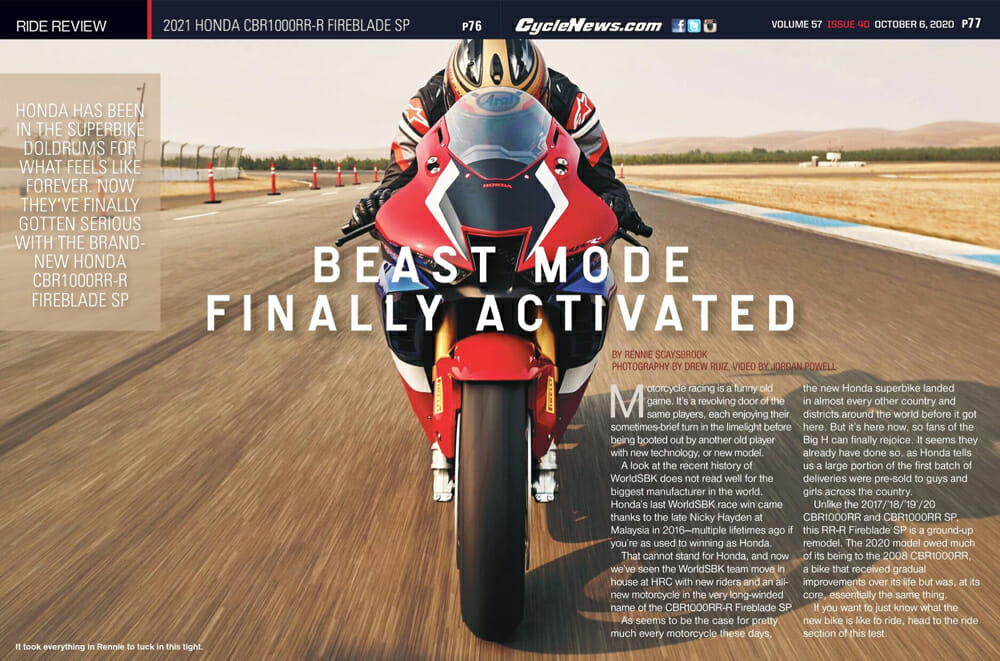Rennie Scaysbrook | October 8, 2020
Honda has been in the Superbike doldrums for what feels like forever. Now they’ve finally gotten serious with the brand-new Honda CBR1000RR-R Fireblade SP.
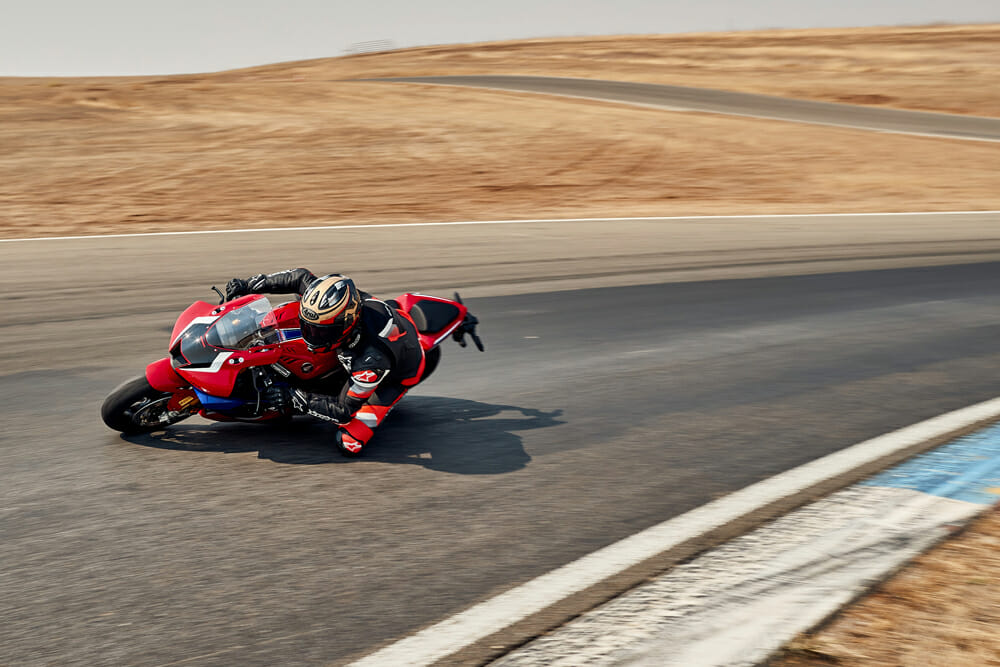 Bank that sucker in and watch it stick. The new Fireblade just devours the corner.
Bank that sucker in and watch it stick. The new Fireblade just devours the corner.
Photography by Drew Ruiz, video by Jordan Powell
Motorcycle racing is a funny old game. It’s a revolving door of the same players, each enjoying their sometimes-brief turn in the limelight before being booted out by another old player with new technology, or new model.
A look at the recent history of WorldSBK does not read well for the biggest manufacturer in the world. Honda’s last WorldSBK race win came thanks to the late Nicky Hayden at Malaysia in 2016—multiple lifetimes ago if you’re as used to winning as Honda.
That cannot stand for Honda, and now we’ve seen the WorldSBK team move in house at HRC with new riders and an all-new motorcycle in the very long-winded name of the CBR1000RR-R Fireblade SP.
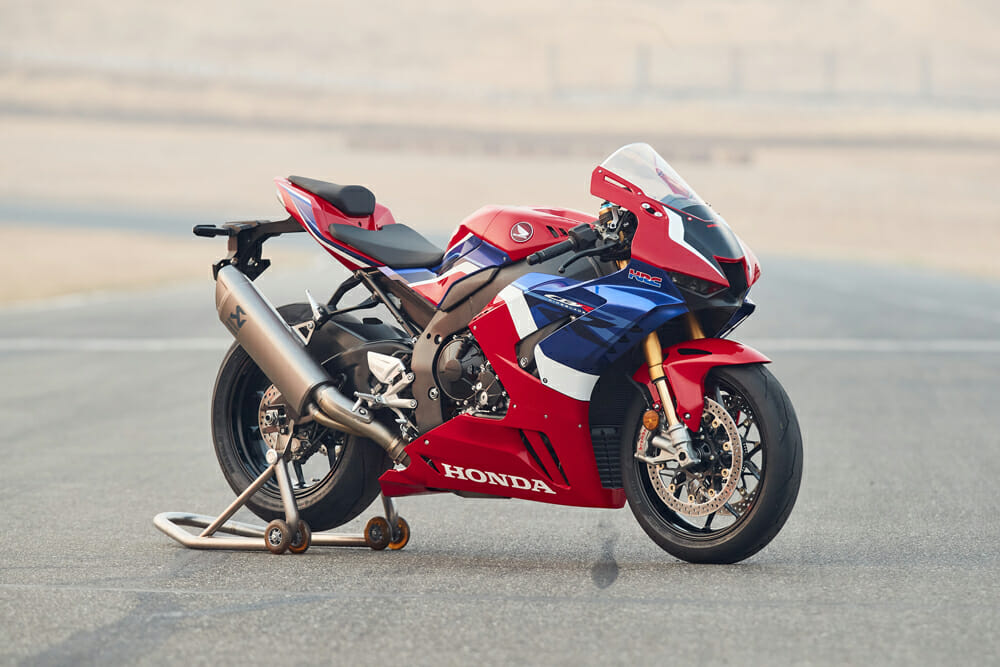 Everything about the new bike screams “race!” It’s about time Honda started taking Superbike racing seriously.
Everything about the new bike screams “race!” It’s about time Honda started taking Superbike racing seriously.
As seems to be the case for pretty much every motorcycle these days, the new Honda superbike landed in almost every other country and districts around the world before it got here. But it’s here now, so fans of the Big H can finally rejoice. It seems they already have done so, as Honda tells us a large portion of the first batch of deliveries were pre-sold to guys and girls across the country.
Unlike the 2017/’18/’19’/20 CBR1000RR and CBR1000RR SP, this RR-R Fireblade SP is a ground-up remodel. The 2020 model owed much of its being to the 2008 CBR1000RR, a bike that received gradual improvements over its life but was, at its core, essentially the same thing.
If you want to just know what the new bike is like to ride, head to the ride section of this test.
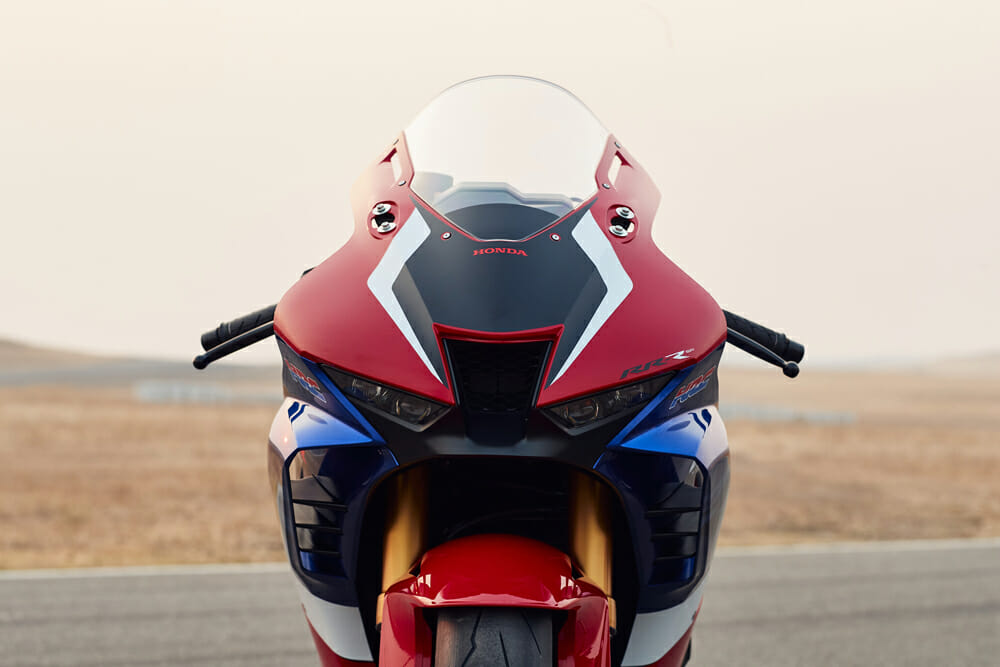 The new wings add the same downforce as Marc Marquez’s 2018 racer.
The new wings add the same downforce as Marc Marquez’s 2018 racer.
2021 Honda CBR1000RR-R Fireblade SP Review | Motor
What’s new in the motor? In a word—everything. The CBR1000RR-R Fireblade SP has been designed as a race bike first, road bike second, in much the same guise as the Ducati Panigale V4 R and the Yamaha YZF-R1M. But it’s not simply a matter of shrinking the chassis, or upping the engine specs, or throwing a bunch of electronics at the bike. It’s a combination of all three.
The genes of Honda RC213 V-S of 2015 can be found littered throughout the Fireblade, including the bore and stroke of 81 x 48.5mm. The 81mm bore is now the MotoGP-class standard, something those with long memories will remember Ducati was very vocal about when they introduced the Panigale V4 S back in 2018.
The new over-square motor is a dramatic deviation from the previous-generation CBR, which ran with 76 x 55mm bore-and-stroke figures. As such, the new Fireblade has the largest bore size in the inline 1000cc superbike class (Kawasaki and Suzuki use 76mm, BMW has 80mm and Yamaha’s got 79mm). Only the 998cc Panigale V4 R, and the over-1000cc bikes V4 S and Aprilia RSV4 1100 Factory use an 81mm bore.
On the other side, the dramatically shorter 48.5mm stroke hints at what’s to come when you crack the throttle. With rods and pistons that don’t have to travel as far as before, you’ll get a much faster revving motor and in theory it should translate to better top-end performance.
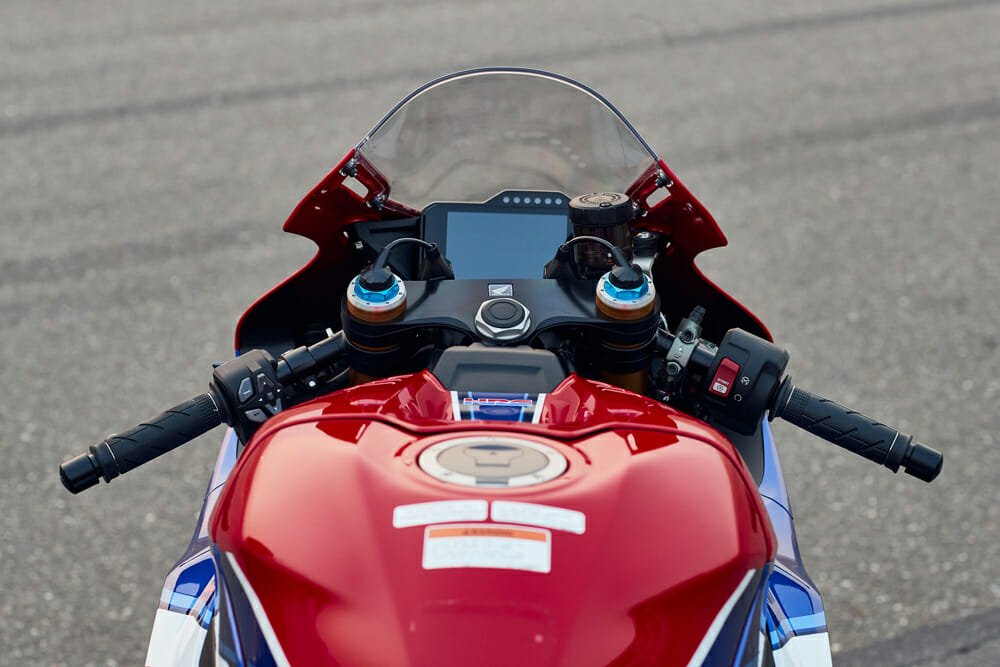 The removal of the ignition barrel from the top triple clamp allows for a straighter ram-air duct.
The removal of the ignition barrel from the top triple clamp allows for a straighter ram-air duct.
Another factor in the faster revving capability of the new motor is the Jenny Craig weight-loss program it’s gone on. Titanium conrods are used for the first time in the Fireblade, resulting in a 50 percent weight reduction over the steel units used in 2020 and before. These rods are now clamped to the crank by a single bolt, whereas before you’d have the stud protruding from the bottom of the rod and the cap secured by a locking nut, as per basically every engine ever made.
New, forged alloy pistons save a total of 20 percent in weight and pivot on the top of the conrod via new beryllium copper small ends bushings. These pistons use a multi-point jet that sprays cooling oil in various directions under the piston through each combustion cycle at high revs. At low revs, the jet flow is shut off by a series of check balls, which helps limit oil-pressure loss and reduces friction—the old motor used this system at all rpm, but Honda’s now saying it’s only needed at high rpm.
And the new finger-follower rocker arm valve-actuation system saves weight by an impressive 75 percent over the old shim-under-bucket design (it should be noted that BMW pioneered this design with the first S 1000 RR way back in 2010, so it’s nice to see Honda finally join the finger-follower party).
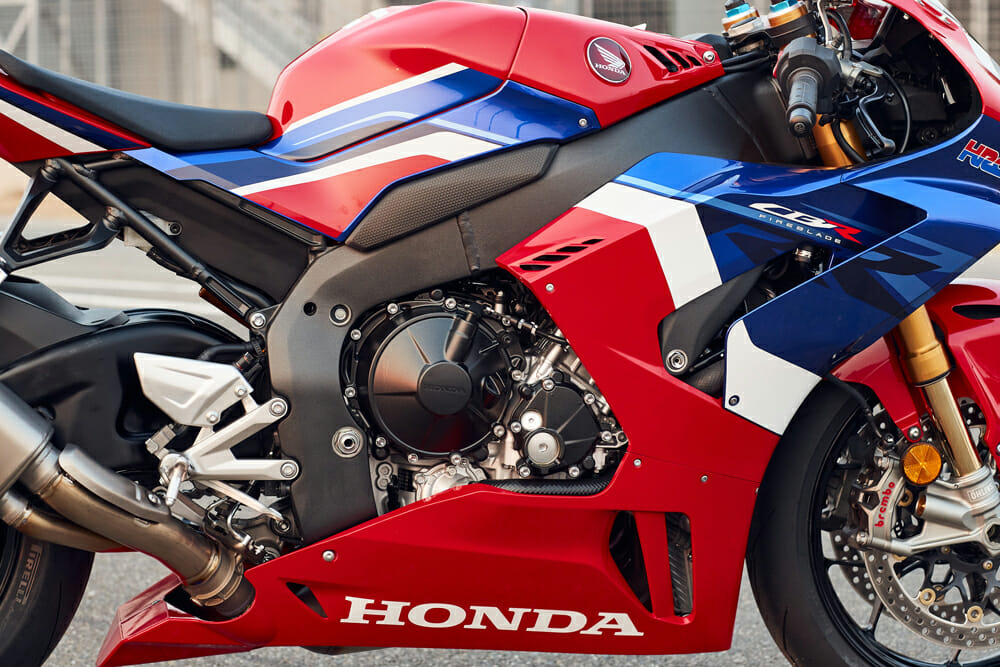 The center of gravity has been raised with the crankshaft 33mm further back from the front axle and 16mm higher up in the engine block.
The center of gravity has been raised with the crankshaft 33mm further back from the front axle and 16mm higher up in the engine block.
Honda’s also used Diamond Like Carbon (DLC) on the cam lobes, just as they did on the RC213 V-S, which reduces friction by a claimed 35 percent. Interestingly, the valve train itself is driven by a semi-cam gear train, where the cam chain is driven by the timing gear on the crank via the cam idle gear, helping make the system shorter top to bottom.
The motor has a 0.2 bump in compression to 13.2:1 with the rev ceiling up 500 rpm to 14,500 rpm, and 32.5mm intake and 28.5mm exhaust valves (previously they were 29.5mm and 24.0mm). Those valves are now at a reduced 9-percent incline (down from 11-percent), to reduce the surface area in the combustion chamber, resulting in a tiny but still important two-percent gain in intake efficiency. It’s all part of a new intake that includes beefed up 52mm throttle bodies (up 4mm), and full ram-air induction modeled on the 2013 Honda RCV213V (Marc Marquez’s first title winner). This new induction uses the straightest funnel Honda’s yet produced with airbox volume increasing by 25 percent on the air filter (top) side.
One of the cool features (even though I hate perimeter keys), is that Honda hasn’t just removed the ignition barrel for the sake of removing the ignition barrel. It’s gone so the engineers could make even more space for the ram-air system, allowing more life-giving oxygen to come in.
And just to let you know, the intake noise is beeeeeefy!
Getting all those spent gasses out is the job of the new exhaust, which interestingly runs steel—not titanium—for the headers, although Honda’s teamed up with Akrapovic to develop and construct a beautiful titanium muffler with a new exhaust valve and stopper. This is where the emissions police have stepped in somewhat to try and reduce the screaming noise of Honda’s new missile, but it also helps Honda engineers tune both low-end torque and high-rpm power.
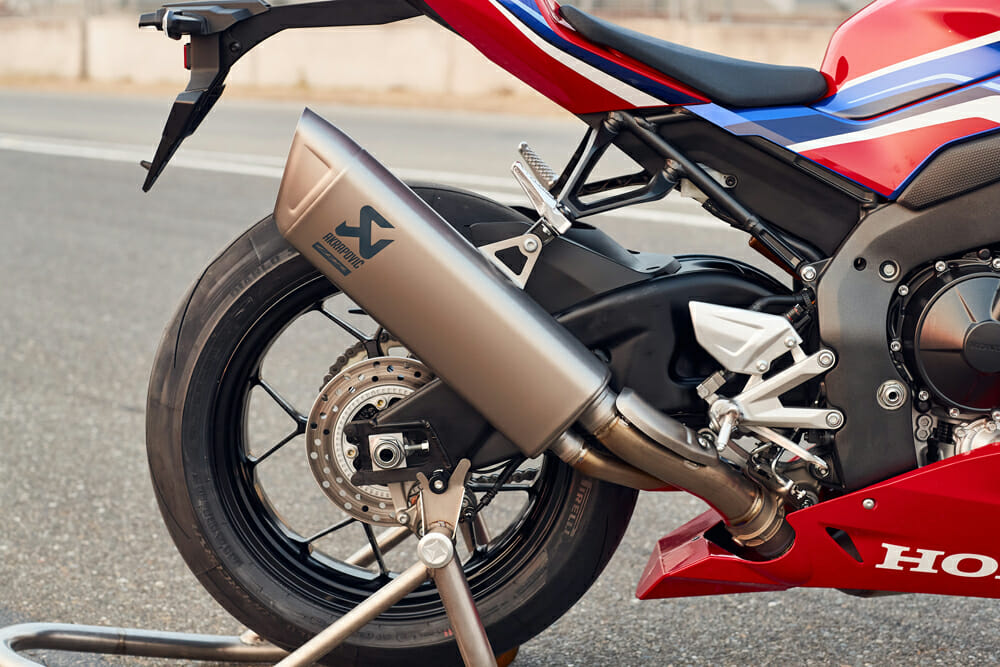 That beautiful Akrapovic exhaust sure has a note to it!
That beautiful Akrapovic exhaust sure has a note to it!
2021 Honda CBR1000RR-R Fireblade SP Review | Chassis
Like the motor, the chassis has come in for a top-to-bottom makeover. The aim was more vertical (18 percent) and torsional (nine percent) rigidity, but less horizontal rigidity (11 percent) for better side-of-the-tire behavior and rider feel, with the engineers totally revising the geometry in the process.
The frame is constructed using four 2mm aluminum sections and connects to the engine in six spots, with less rake but more trail 24°/4.01 inches vs 23°/3.77 inches, and the wheelbase has been increased by 2.1 inches via a swingarm that’s 1.2 inches longer than in 2020. There are 18 individual thicknesses of pressed aluminum that make up the swingarm, with its horizontal rigidity also reduced by 15 percent.
The idea of all this reduced horizontal rigidity is that when you lean the Fireblade on its side, it’s not as susceptible to road corrugations, will help stay on your chosen line, generate more grip from the rubber, and give you more feel while it does so.
Another big change is the shock is now mounted directly from the linkage off the swingarm to the motor rather than the frame, which helps reduce the loads put through the chassis.
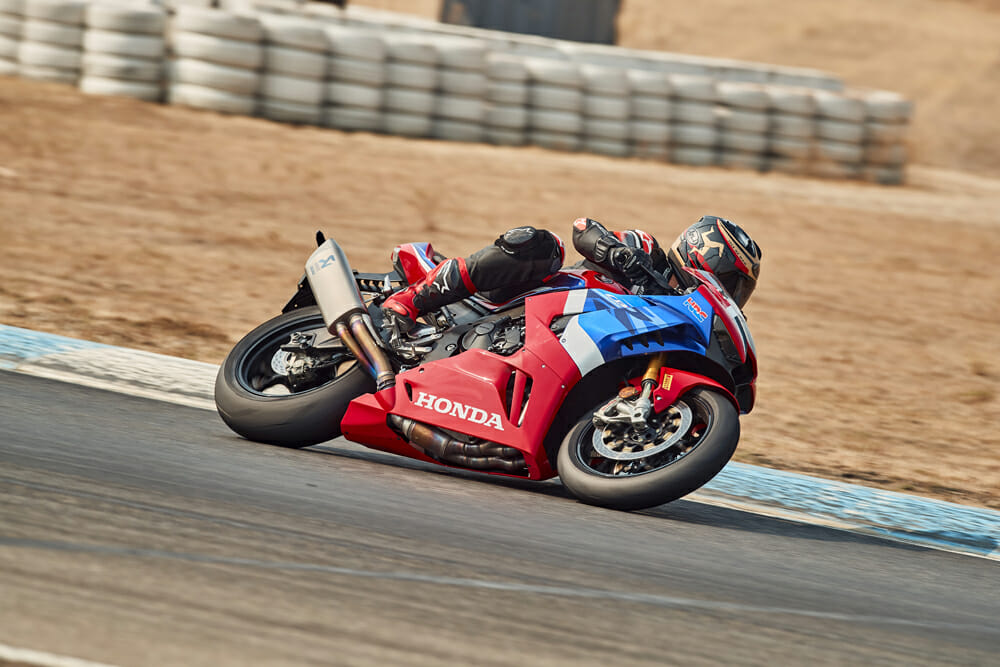 Braking performance is drastically improved on the new Fireblade, as is how it goes from upright to full lean.
Braking performance is drastically improved on the new Fireblade, as is how it goes from upright to full lean.
Geometry-wise, the new Fireblade is a pretty big departure from the old one. The center of gravity has been raised with the crankshaft 1.3 inches further back from the front axle and 0.6 inches higher up in the engine block. Honda claims the new crank position helps even out the weight distribution (but they declined to mention just what the front/rear percentage is).
The wheelbase has been upped 1.7 inches to 57.3 inches, partly due to the longer swingarm but also because of its mounting position in the chassis. The seat height is down 0.4 inches to 32.6 inches; handlebar height down 0.7 inches to 33.1 inches, and the pegs are 0.8 inches higher and 1.7 inches further back than on the 2020 version. These figures are telling, showing the rider is now hunched much further forward and lower down and with the gas tank cover now 1.8 inches lower than last year, it makes for a very racy ride position.
The six-inch-wide rear-wheel size has been boosted from a 190/50 ZR17 to a fat ol’ 200/55 ZR17, which helps with not only tire selection but also minimizes the geometry changes when switching to track rubber.
Those familiar with the Ducati Panigale V4 S will recognize the suspension in the 43mm Ӧhlins NPX Smart EC 2.0 electronically adjustable units up front, matched to a class standard TTX36 Smart EC shock at the rear.
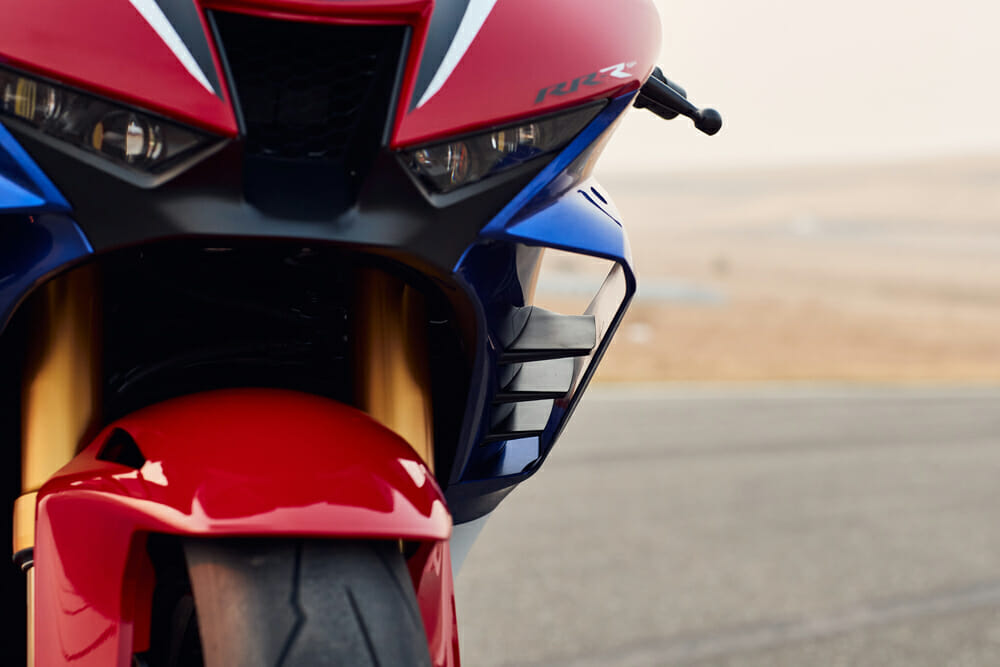 Another gratuitous wing shot.
Another gratuitous wing shot.
Honda has utilized a six-axis Inertial Measurement Unit for the 2021 ’Blade over the five-axis unit on the 2020 edition, and the Ӧhlins system is the same Objective Based Tuning interface (OBTi) we’ve seen on the Panigale. You can get absolutely lost in the OBTi system. There’s three auto modes and three manual modes, each with their own default of Track, Sport and Rain. The damping is controlled by the IMU and the ECU, and riders can store three combinations of individual settings from across all the modes—like having three track settings, if you wish.
The OBTi system doesn’t work by traditional preload, rebound and compression. Instead, in Auto Mode, it’s Front Stiffness, Rear Stiffness and Braking. If you switch to the Auto Track mode, you also get Acceleration and Cornering as an option. Need more stability under braking? Dialing in braking. Squatting too much on the rear under throttle? Dial in acceleration. You get the idea.
The three manual modes are the old-school way, with front and rear compression and rebound adjusted via the dash (but only with pre-selected numbers, and C-spanners/wrenches used for preload adjustment).
Honda has also fitted the revised electronic steering damper, with three settings available to you in soft, medium or hard. Honda has been a firm believer in the electronic-steering-damper setup, going way back to the mid-2000s to find the original version.
The brakes are now the vastly superior Brembo Stylema four-piston calipers clamping 10mm larger discs at 330mm and matched to a Brembo radial master-cylinder. ABS is given Sport and Track modes, although neither mode allows you to disengage ABS on the rear caliper, which incidentally is the same single-piston unit as on the RC213 V-S.
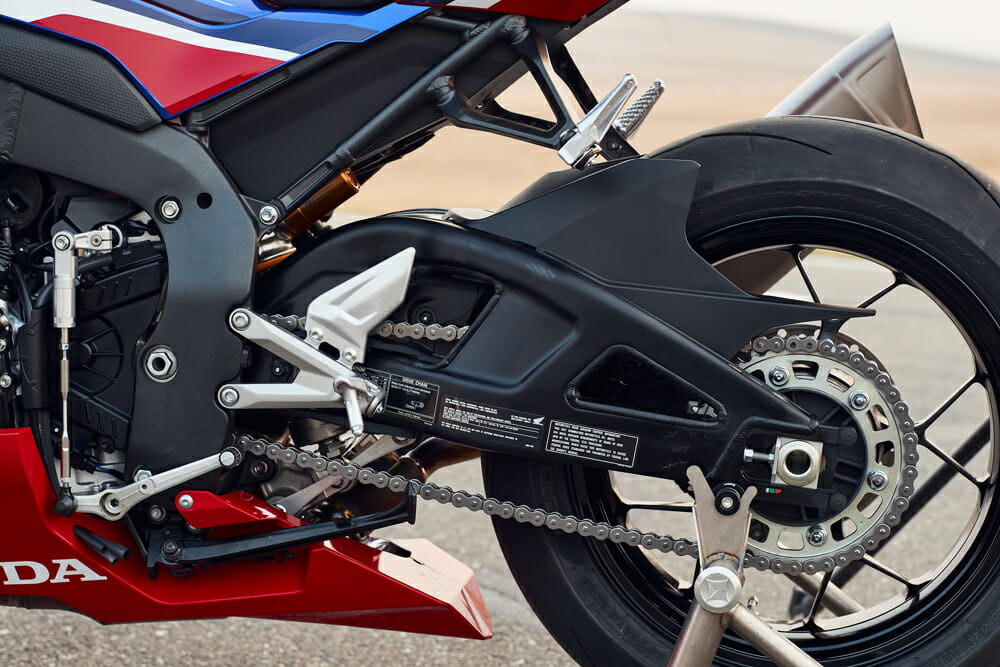 There are 18 individual thicknesses of pressed aluminum that make up the swingarm, with its horizontal rigidity reduced by 15 percent.
There are 18 individual thicknesses of pressed aluminum that make up the swingarm, with its horizontal rigidity reduced by 15 percent.
2021 Honda CBR1000RR-R Fireblade SP Review | Electronics
We’ve kind of segued into the electronics with the suspension, so let’s just keep the gas on, shall we?
Honda’s revamped the traction-control system (its actual name is Honda Select Torque Control—HSTC), with nine levels plus Off, although Honda still seems to have a bee in its bonnet about the relationship between traction and wheelie control. Back in 2017, one of the biggest flaws with that bike was the wheelie and traction control were under the same algorithm. It was a bloody nightmare, especially at a wheelie-prone place like Portimao, where it was launched.
Fast forward to 2021 and the systems are separate, with wheelie control its own three levels. But if you switch off the traction control, you also switch off wheelie control—so in that way, the systems are still linked. Luckily, this is nowhere near as bad as what it was four years ago, but still an odd thing to do from the Big H.
However, the traction-control system is much better than it was before, and in level one there’s almost the perfect amount of slip matched to a safety net that’ll stop you launching yourself to the moon.
The ride-by-wire throttle settings have been altered for a more precise pick-up and matched to three new riding modes, down from the five of the old bike, that give you preset parameters for power, traction, wheelie and engine brake control, as well as suspension adjustment—all of which you can change individually if you like.
There’s also the new launch control, where you can limit engine revs to 6000, 7000, 8000 or 9000 rpm for the ultimate launch. Basically, you engage the system, pin the throttle and modulate the clutch to keep the revs in the ideal spot. And it’s not as easy as it seems. All the journalists at the Thunderhill launch had a go on the system, and only one got a semi decent start. The result? Two CBR1000RR press bikes with knackered clutches.
The dash is another big change. It’s a five-inch TFT, with five different options for layout and six different tachometer styles depending on your preference. It’s all adjusted (everything—suspension, modes, traction, engine brake control—everything) via the four-way switch on the left handlebar.
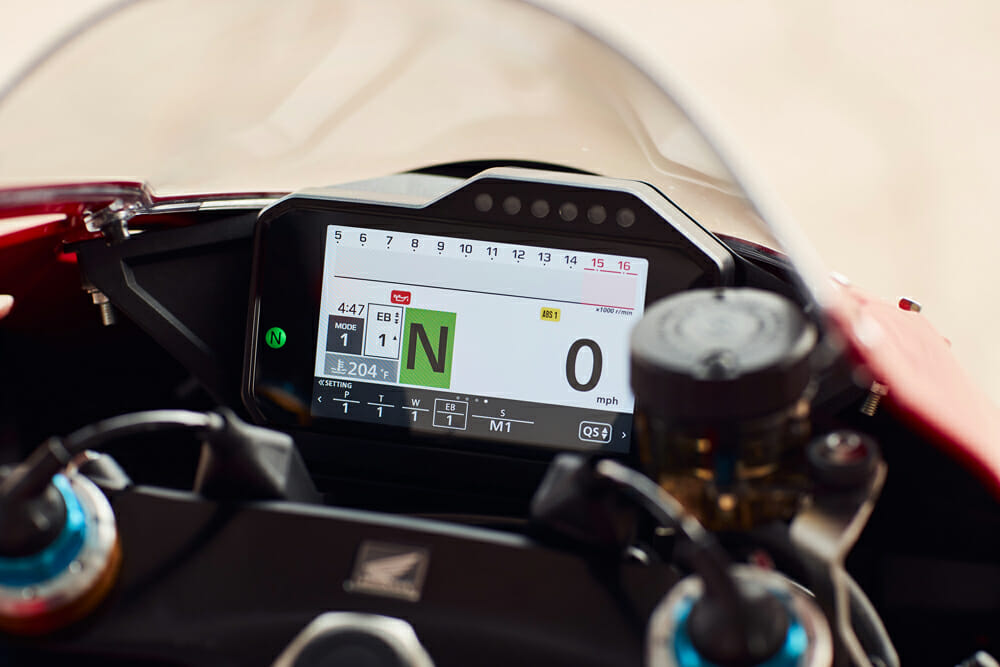 You get six options of dash with the new Fireblade.
You get six options of dash with the new Fireblade.
2021 Honda CBR1000RR-R Fireblade SP Review | Bodywork
We’re almost there, I promise.
Any manufacturer worth its salt in racing these days needs wings, but it’s not simply a case of grafting them on the bike and going racing. You need to homologate them, hence Ducati with its wing setup and, well, almost everyone else.
Honda has now followed suit and delivered bodywork with said wings, which deliver the same downforce as Marc Marquez’s 2018 racer but with a smaller area (the Marquez 2018 RCV had long, wide wings, almost like a handlebar mustache. The CBR’s wings are much neater).
As mentioned earlier, the gas tank cover is 1.8 inches lower than in 2020, plus there’s a flatter screen angle which is great for short riders, not so great for taller riders.
Oh, and there’s fancy new HRC-style colors, in case you hadn’t noticed those.
Right. Got all that? Let’s go for a ride.
VIDEO | 2021 Honda CBR1000RR-R Fireblade SP Track Test
2021 Honda CBR1000RR-R Fireblade SP Review | Riding Impression
That’s an absolute boatload of information to take in with regards to a new motorcycle, but in practice, it all combines for a much more dynamic and, let’s face it, racier riding experience than in 2020 when we tested the new steed at Thunderhill in Northern California.
The first thing you notice when climbing on board the 2021 is the ergonomics. With that lowered tank height and the peg position, you’re immediately put into that crouch-rocket stance that feels almost awkward if you’re not really going for it with the throttle pinned.
The handlebar position is flatter and wider, allowing for more leverage when cornering and making it a little easier to tuck your torso under the screen than the old bike.
Interestingly, Honda gave us the opportunity to ride the 2020 CBR1000RR SP at the 2021 launch, which is something manufacturers—let alone Honda—never do. So, thanks, Honda. That was nice of you.
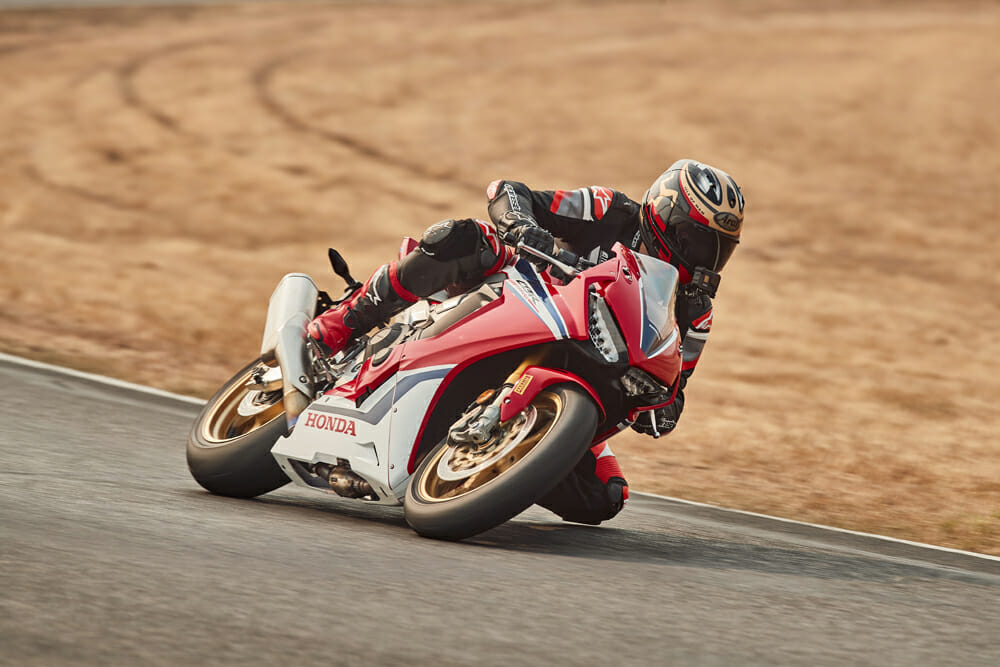 Honda gave us a run on the old girl 2020 edition, which proved there was some life left in her yet.
Honda gave us a run on the old girl 2020 edition, which proved there was some life left in her yet.
When compared back-to-back, you can tell the DNA of the two bikes but the 2021 is much more purpose built. I rather like the ride position of the old bike, given that the pegs are a bit lower, the ride position a little more relaxed. The 2021 model’s peg-to-seat distance was too short for my 6’1” frame, simply as I have longer legs than in relation to my torso. It’s nothing a set of rearsets won’t fix.
The 2020 bike is, dare I say, quite easy to ride. It also feels lazier, in everything from cornering to acceleration and especially braking. And that, let me tell you, is a good thing.
That shows Honda is on the right path with the 2021 machine. We’ll start with the motor, and unfortunately, there’s an issue BMW is well familiar with.
The emissions police have sunk their teeth into the new Fireblade, which has dulled the bottom-end power delivery. Coming out of the second-gear left hander at the back of the pits (turn 11) and nailing the throttle at 7000 rpm was met with delinquency, as the motor labored past the 7-8500 rpm flat spot. Once clear, the motor ripped through the remaining 5000 or so rpm like it was child’s play. It’s a great shame this is the case, and, to be fair, it’s not Honda’s fault. The emissions police are not just after C02’s. Noise is now taking almost as much precedent, especially intake noise (to be fair, both intake and exhaust noise are, err, rather loud on the new CBR).
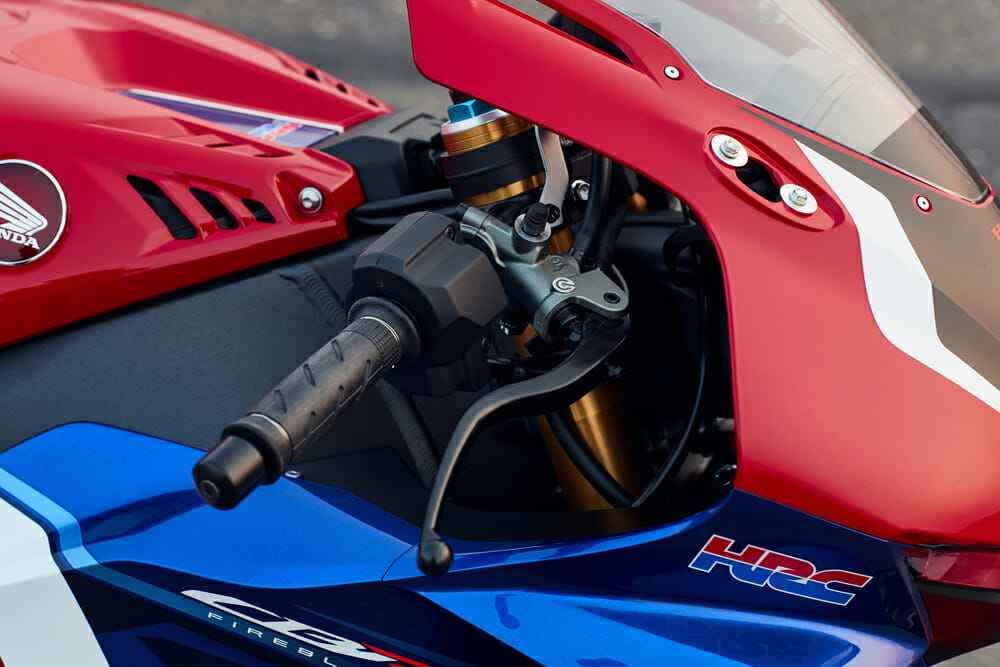 Love that new Brembo master-cylinder.
Love that new Brembo master-cylinder.
However, you can tell the engine has good bones. Once the motor is cleared of all that crap and tuned by some skilled hands, this thing will be an absolute rocket on the racetrack.
On the plus side for the street bike, at least, is a beautiful throttle response, at either low or high rpm. You should ride the new CBR like a supersport bike (at least in emissions form), keeping the revs up and the motor spinning hard. Do that, and you’ve got power to burn with a velvet-glove touch, matched to one of the sweetest, most direct quickshifter gearshifts I’ve ever seen on a production motorcycle.
Another area the 2021 bike dominates is the chassis. It’s simply on another level compared to the 2020 CBR, which in itself was no slouch in the corners. The 2021 will go from upright to full lean in the blink of an eye, and once it’s there, the motorcycle offers vastly better side-of-the-tire feel and feedback. The second generation Ӧhlins electronic suspension is a big improvement over the first-gen stuff on the 2020, although I’ll admit to not being that surprised to their abilities given, I’ve spent some decent time on them with the new Panigale.
This suspension, combined with that excellent throttle response and the supreme grip from the Pirelli Supercorsa SP rubber, allows you to dial in more and more throttle earlier and earlier in the corner, constantly urging you to max out acceleration drive.
Here, the new electronics come to the fore. Once I’d played around with them, I dialed everything back to level one, with the most power, least traction and wheelie control, and the most engine braking, and the CBR was an absolute gem to experience.
 That new gearshift is one of the best in the superbike class.
That new gearshift is one of the best in the superbike class.
The electronics cut in far less intrusively than before, yet you still know they’re there in the background. Conversely, dial them up even just a couple of levels to level three, and they become quite intrusive. Zack Courts, a man whose opinion in the bike testing game is highly sought, said he’d prefer a level between one and zero, almost a 0.5, if you will. That, he felt, would be the ideal level of electronic intervention. He might be onto something.
Back to the mechanicals, and one of the biggest areas of improvement is the brakes. With the new Brembo radial master-cylinder matched to the Stylema calipers, it really shows how rubbish the brakes on the 2020 edition were. Both bikes come with ABS you can’t switch off, but the 2021 edition has so much more power and feel it’s pretty comforting.
Another fact is the 2021 is much more stable at high speed. Top speed we got at Thunderhill was about 150 mph on the dash, with the 2020 a bit more flighty than the new bike. All I can put this down to is the winglets, but I think it’s a combination of the ride position, the lower overall stance and the wings. I’m not an engineer, but from the hot seat I can tell you something’s working that isn’t on the 2020.
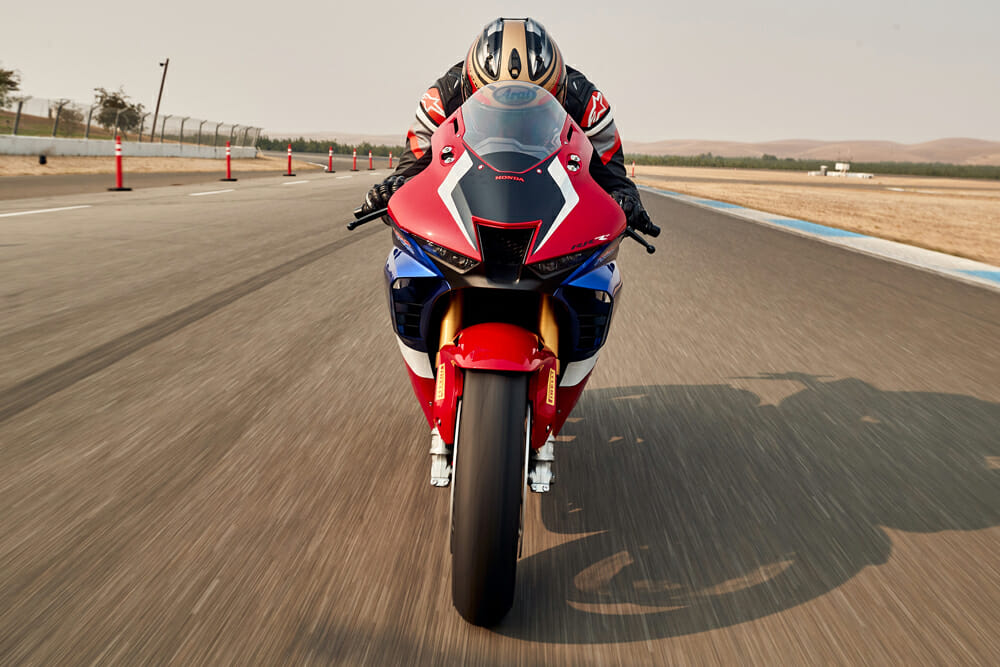 It took everything in Rennie to tuck in this tight.
It took everything in Rennie to tuck in this tight.
The 2021 Honda CBR1000RR-R Fireblade SP is the bike Honda really should have built five years ago. Rather than labor with an old, revamped bike, they should have done this when Nicky came to the series all those years ago. It’s a vastly superior bike to the 2020 edition, and proof Honda is finally taking Superbike competition seriously.
Once the motor is tuned properly, this thing will be a weapon and right on par with the best from Japan and Europe. In production guise, despite the emissions flat spot, it’s still an excellent bike. The build quality is top-notch, the chassis is brilliant, and racy ethos now at the fore.
And it’s about time. CN
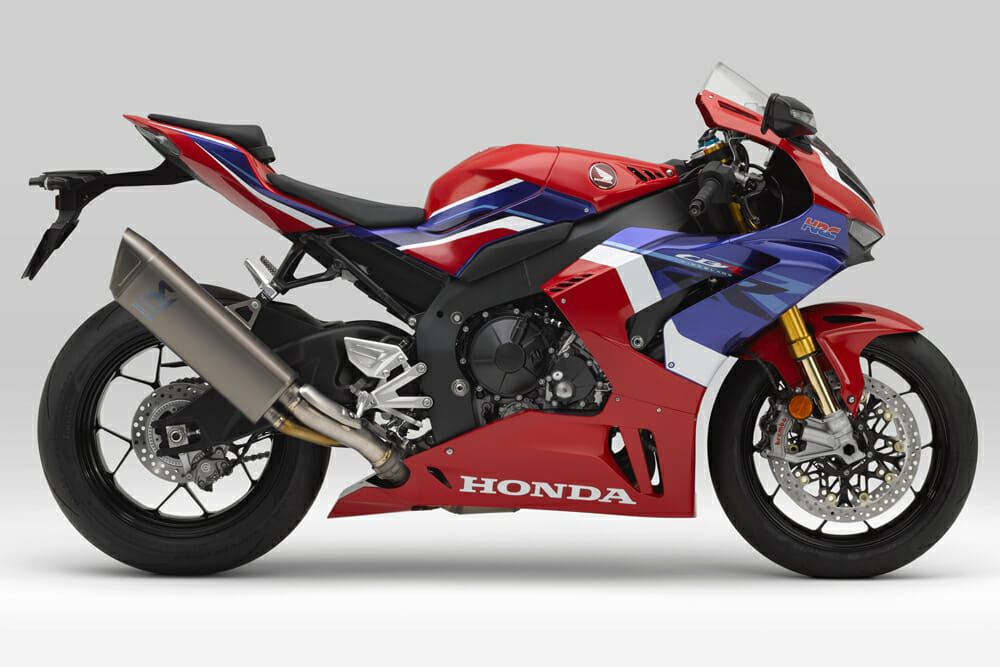
2021 Honda CBR1000RR-R Fireblade SP Specifications
|
|
| MSRP: |
$28,500 |
| Engine: |
Liquid-cooled inline-four-cylinder, 4-stroke |
| Fueling: |
EFI |
| Displacement: |
999cc |
| Bore x stroke: |
81 x 48.5mm |
| Power (claimed): |
186 hp at 12,000 rpm |
| Torque (claimed): |
83 lb-ft at 11,000 pm |
| Transmission: |
6-speed |
| Clutch: |
Wet multi-disc |
| Chassis: |
Twin-spar aluminum |
| Front suspension: |
Öhlins NPX 43mm telescopic fork with Electronic Control (S-EC) |
| Rear suspension: |
Pro-Link system; single Öhlins shock w/ Electronic Control (S-EC) |
| Front-wheel travel: |
4.9 in. |
| Rear-wheel travel: |
5.6 in. |
| Front brake: |
Two 330mm discs, Brembo Stylema 4-piston radial-mount hydraulic calipers; ABS |
| Rear brake: |
Single 220mm disc, Brembo hydraulic calipers; ABS |
| Front tire: |
120/70 ZR17 |
| Rear tire: |
200/55 ZR17 |
| Seat height: |
32.6 in. |
| Wheelbase: |
57.3 in. |
| Rake: |
24° |
| Trail: |
4.0 in. |
| Fuel capacity: |
4.3 gal. |
| Weight (curb, claimed): |
443 lbs. |
